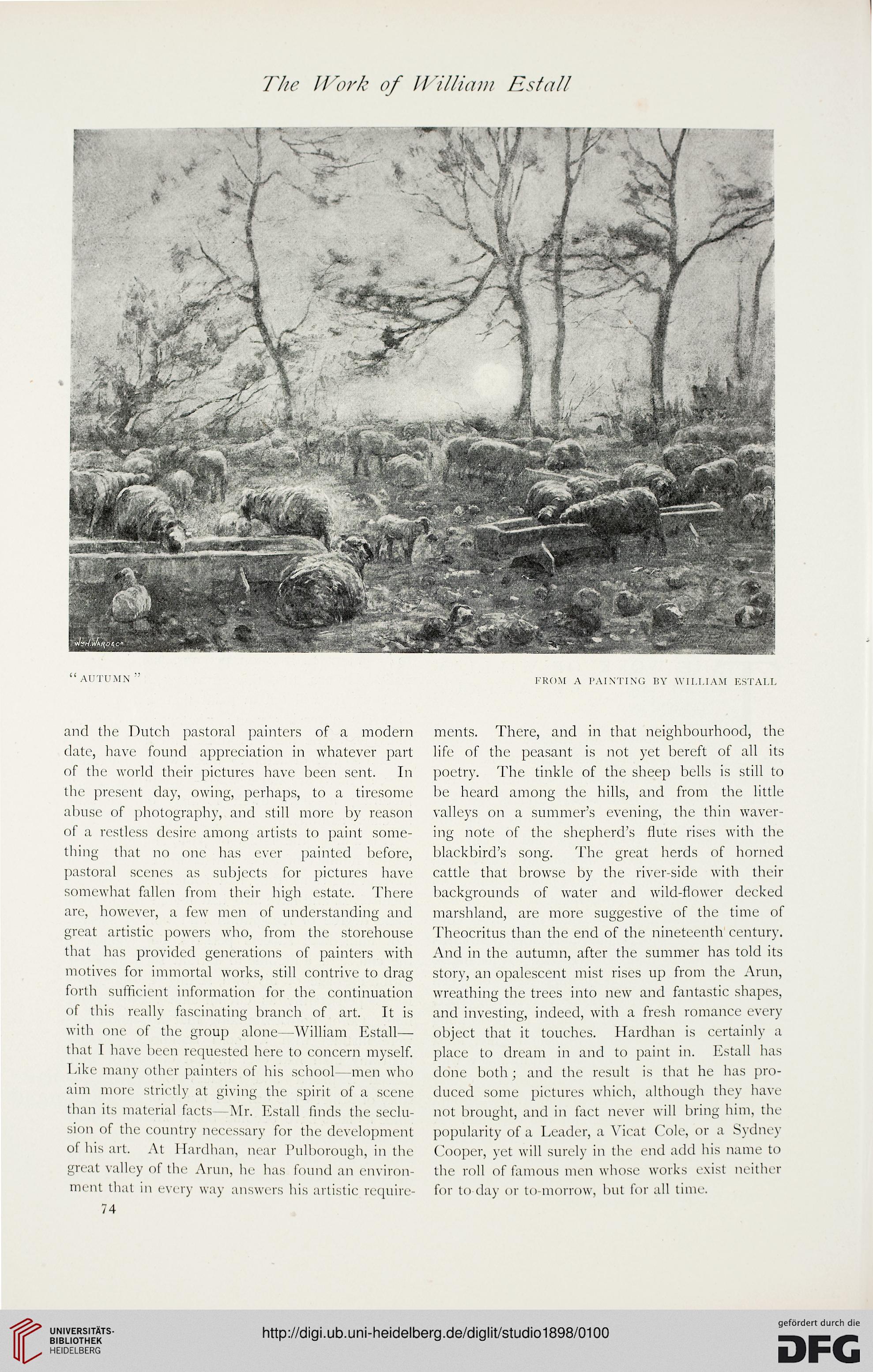The Work of William Estall
FROM A PAINTING BY WILLIAM ESTALL
and the Dutch pastoral painters of a modern merits. There, and in that neighbourhood, the
date, have found appreciation in whatever part life of the peasant is not yet bereft of all its
of the world their pictures have been sent. In poetry. The tinkle of the sheep bells is still to
the present day, owing, perhaps, to a tiresome be heard among the hills, and from the little
abuse of photography, and still more by reason valleys on a summer's evening, the thin waver-
of a restless desire among artists to paint some- ing note of the shepherd's flute rises with the
thing that no one has ever painted before, blackbird's song. The great herds of horned
pastoral scenes as subjects for pictures have cattle that browse by the river-side with their
somewhat fallen from their high estate. There backgrounds of water and wild-flower decked
are, however, a few men of understanding and marshland, are more suggestive of the time of
great artistic powers who, from the storehouse Theocritus than the end of the nineteenth century,
that has provided generations of painters with And in the autumn, after the summer has told its
motives for immortal works, still contrive to drag story, an opalescent mist rises up from the Arun,
forth sufficient information for the continuation wreathing the trees into new and fantastic shapes,
of this really fascinating branch of art. It is and investing, indeed, with a fresh romance every
with one of the group alone—William Estall— object that it touches. Hardhan is certainly a
that 1 have been requested here to concern myself. place to dream in and to paint in. Estall lias
Like many other painters, of his school—men who done both; and the result is that he has pro-
aim more strictly at giving the spirit of a scene duced some pictures which, although they have
than its material facts—Mr. Estall finds the seclu- not brought, and in fact never will bring him, the
sion of the country necessary for the development popularity of a Leader, a Meat Cole, or a Sydney
of his art. At Hardhan, near Pulborough, in the Cooper, yet will surely in the end add his name to
great valley of the Arun, he has found an environ- the roll of famous men whose works exist neither
ment that in every way answers his artistic require- for to da)' or to-morrow, but for all time
74
FROM A PAINTING BY WILLIAM ESTALL
and the Dutch pastoral painters of a modern merits. There, and in that neighbourhood, the
date, have found appreciation in whatever part life of the peasant is not yet bereft of all its
of the world their pictures have been sent. In poetry. The tinkle of the sheep bells is still to
the present day, owing, perhaps, to a tiresome be heard among the hills, and from the little
abuse of photography, and still more by reason valleys on a summer's evening, the thin waver-
of a restless desire among artists to paint some- ing note of the shepherd's flute rises with the
thing that no one has ever painted before, blackbird's song. The great herds of horned
pastoral scenes as subjects for pictures have cattle that browse by the river-side with their
somewhat fallen from their high estate. There backgrounds of water and wild-flower decked
are, however, a few men of understanding and marshland, are more suggestive of the time of
great artistic powers who, from the storehouse Theocritus than the end of the nineteenth century,
that has provided generations of painters with And in the autumn, after the summer has told its
motives for immortal works, still contrive to drag story, an opalescent mist rises up from the Arun,
forth sufficient information for the continuation wreathing the trees into new and fantastic shapes,
of this really fascinating branch of art. It is and investing, indeed, with a fresh romance every
with one of the group alone—William Estall— object that it touches. Hardhan is certainly a
that 1 have been requested here to concern myself. place to dream in and to paint in. Estall lias
Like many other painters, of his school—men who done both; and the result is that he has pro-
aim more strictly at giving the spirit of a scene duced some pictures which, although they have
than its material facts—Mr. Estall finds the seclu- not brought, and in fact never will bring him, the
sion of the country necessary for the development popularity of a Leader, a Meat Cole, or a Sydney
of his art. At Hardhan, near Pulborough, in the Cooper, yet will surely in the end add his name to
great valley of the Arun, he has found an environ- the roll of famous men whose works exist neither
ment that in every way answers his artistic require- for to da)' or to-morrow, but for all time
74




